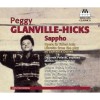Biography
Peggy Glanville-Hicks (29 December 1912 – 25 June 1990) was an Australian composer.
Peggy Glanville-Hicks was born in Melbourne in 1912. At age 15 she began studying composition with Fritz Hart in Melbourne. She also studied the piano under Waldemar Seidel. She spent the years from 1931 to 1936 as a student at the Royal College of Music in London, where she studied piano with Arthur Benjamin, conducting with Constant Lambert and Malcolm Sargent, and composition with Ralph Vaughan Williams. (She later asserted that the idea that opens Vaughan Williams' 4th Symphony was taken from her, and it reappears in her 1950s opera The Transposed Heads .[citation needed]) Her teachers also included Egon Wellesz.
From 1949 to 1958 she served as a critic for the New York Herald Tribune and took out U.S. citizenship.[1] After leaving America, she lived in Greece from 1957 to 1976. In the United States she asked George Antheil to revise his Ballet Mécanique for a modern percussion ensemble for a concert she helped to organize before returning to Australia in the late 1970s.[2] She lost her sight in the last years of living in the U.S. as a result of a brain tumour. She had this tumour successfully removed in a marathon operation and regained her sight. However, a result of this operation was her loss of a sense of smell.
She died in Sydney in 1990. Her will established the Peggy Glanville-Hicks Composers' House in her home in Paddington, Sydney, as a residency for Australian and overseas composers.[3]
Major works in her output include the Sinfonia da Pacifica, Etruscan Concerto, Concerto romantico, and her Harp sonata which was premiered by Nicanor Zabaleta in 1953 as well as several operas. Her best known operas are The Transposed Heads and Nausicaa. The Transposed Heads is in six scenes with a libretto by the composer after Thomas Mann and premiered in Louisville, Kentucky on 27 March 1954.[4]
Nausicaa was composed in 1959-60 and premiered in Athens in 1961. The libretto was prepared together with Robert Graves in Majorca in 1956, based on his novel Homer's Daughter.[5]
Her last opera, Sappho, was composed in 1963 for the San Francisco Opera, with hopes that Maria Callas would sing the title role. However, the company rejected the work and it has never been produced.[6] This opera was recorded in 2012 by Jennifer Condon conducting the Orquestra Gulbenkian and Coro Gulbenkian with Deborah Polaski in the title role.
She was married to British composer Stanley Bate, who was gay,[7] from 1938 to 1949, when they divorced.[8] She married journalist Rafael da Costa in 1952; the couple divorced the following year.[9] She was also involved with Mario Monteforte Toledo and Theodore Thomson Flynn.[10] Like Bate, many of the men with whom Glanville-Hicks was close were gay; she had few intimate female friends, and often dressed in male attire.[11] She was an intimate friend of the expatriate U.S. writer and composer Paul Bowles, and they remained very close all their lives.







